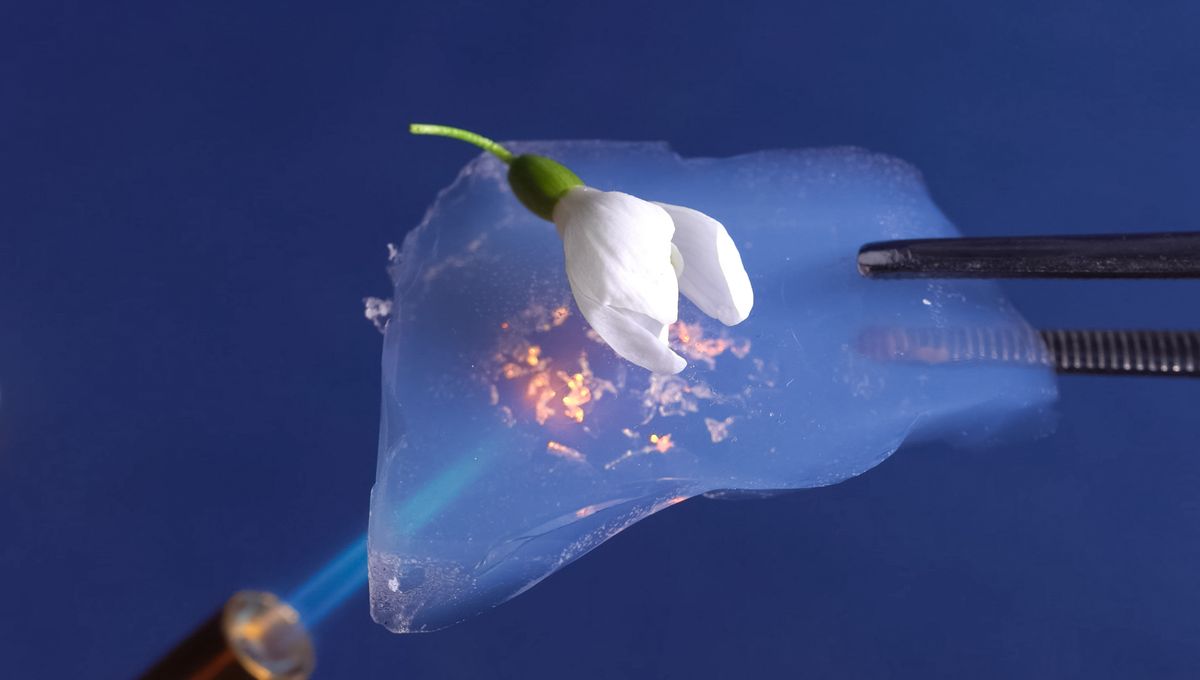
If asked to make the lightest (least dense) solid possible, many people would start looking at the start of the periodic table for low-mass atoms. However, nature shows there are much better ways to lower something’s density, and humans have taken the approach much further.
Volcanoes spit out lava that becomes heavy basalt, but sometimes they also release rocks that float on water in the form of pumice. It’s not necessarily that the substance of the rock is composed of lighter elements, but the large gaps, which become filled with air, allow the pumice to not only float but sometimes form vast rafts.
Aerogels take a similar approach. As their name suggests, they are made initially as gels, but then the liquid is drawn out to be replaced by gas. This sounds simple, but it’s a delicate matter to draw as much material as possible to minimize weight, while also keeping what remains rigid enough to avoid collapse.
Indeed, the first recorded aerogel is said to have been the result of a bet over whether the liquid in a jelly could be removed without shrinkage. It’s been almost a century since the approach was proven possible, and in that time we’ve got very good at freeze-drying or supercritical-drying materials to make aerogels more than 90 percent, and often more than 99 percent, air by volume.
The record-holder for lightness among aerogels as of around a decade ago was aerographene, and if anything less dense has been made since we can’t find an indication of it.
In addition to their weight savings, aerogels prevent heat transfer through conduction and convection. Air is a very bad conductor of heat, and the pockets in which the air is trapped within an aerogel are each so small there is almost no movement. This makes aerogels excellent thermal insulators, particularly if the solid part is something that is a good insulator on its own, like silica. They’re also excellent at noise reduction.
An aerogel made of the usually very heavy element gold not only floats on water, but could serve as an ideal catalyst.
Aerogel innovation is particularly focused on space exploration. NASA used one to collect cometary dust particles the birth of the Solar System. The particles were moving so fast relative to the spacecraft they had to be slowed down in order to be captured, which had to be done in a way that didn’t cause them to vaporize. The particles may even be from interstellar space.
More speculatively, aerogels have been proposed as a way to make vast domes on Mars, under which future colonists could live almost normally without spacesuits. Being so light, aerogels would not need strong reinforcements to hold them up, and some would let visible light through, while blocking dangerous levels of ultraviolet. By preventing infrared radiation from escaping, the aerogels could keep the enclosed area warm, and plants grown underneath could produce enough oxygen to breathe. Even a small meteor strike might kill the entire colony, but you can’t have everything.
Aerogels don’t have it all their own way when it comes to being lightest, however. Only something exceptionally porous, with far more space for gas than solid, could compete, but there are other ways to achieve that. Not only do we have the example of volcanoes, but bakers have been using the carbon dioxide produced by yeast to make bread light and fluffy for thousands of years.
Metal-organic frameworks (MOFs) are an example of an alternative porous material. Their name indicates what they are made from, but MOFs’ key feature is that they have large spaces inside them that can trap individual molecules, with hydrogen and carbon dioxide being popular targets. MOFs have enormous surface areas relative to their volume, potentially the largest known, which makes them very light.
Being a newer technology, however, we don’t really know how light MOFs can get. Not long ago, there was great excitement that MOFs might revolutionize everything from hydrogen storage to the capture of greenhouse gases. We might have seen ever-lighter versions that would allow them to compete with aerogels for the title, but progress hasn’t been as rapid as anticipated, so aerogels will probably maintain their status for a while yet.
All “explainer” articles are confirmed by fact checkers to be correct at time of publishing. Text, images, and links may be edited, removed, or added to at a later date to keep information current.
Source Link: What Are The Lightest Solids And Why Do They Matter?